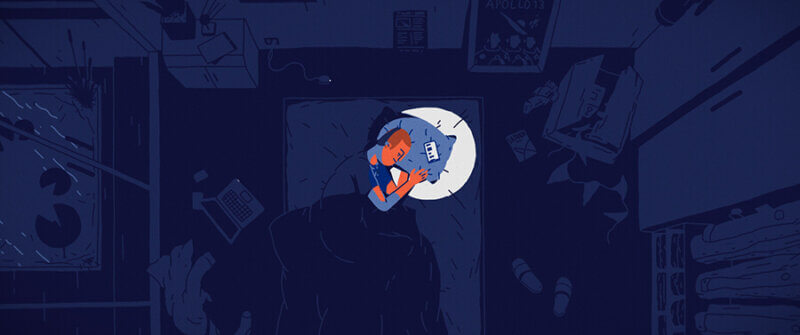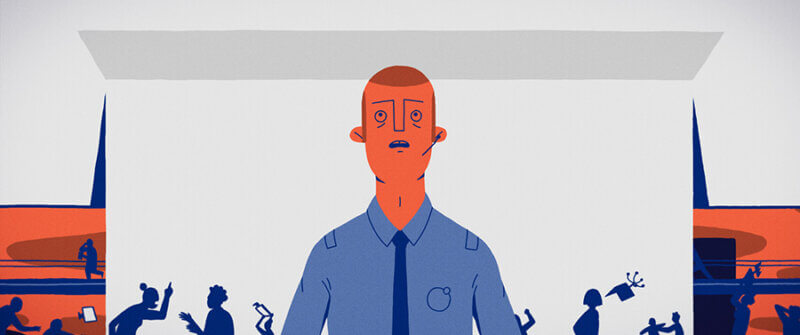The Lonely Orbit Animated Short Available Online – Plus Directors Q&A

The Lonely Orbit (Dir. Frederic Siegel and Benjamin Morard)
Following its successful festival run (screened at over 70 film festivals) and qualifying for this years Academy Awards (thanks to the award for Best Animated Short Film at the Sitges International Fantastic Film Festival 2019), the Swiss animated short The Lonely Orbit is now available free to watch online.
The sci-fi drama, co-directed by Frederic Siegel and Benjamin Morard, tells the tale of “a satellite technician who keeps solitude at bay by constantly texting his old friends. After neglecting his duties, a satellite leaves its orbit which causes the worlds communication network to collapse.”
Although the story of The Lonely Orbit was written in 2016, the themes of isolation, loneliness and longing are more relevant than ever during the Corona crisis. Additionally, digital communication has become much more important during lockdowns to stay connected with friends and family.
The film was produced by the Zurich-based creative collective Team Tumult; which works primarily with hand drawn animation on graphic tablets in combination with digital cut out.
The Lonely Orbit – Directors Q&A
How did you come up with the story for The Lonely Orbit?
Frederic Siegel (FS): The Idea developed in my head a few years after I graduated from Lucerne School of Art & Design. I suddenly realised, how hard it is to keep friendships alive over a distance. After being together almost everyday during our studies, most of our communication now shifted into the digital realm. And somehow this made me feel like a satellite; being constantly connected in a virtual sense, but actually separated over a huge distance. I’m floating in an orbit around my friends, who are holding me close with their gravitational pull.
What was the reason behind the film being a co-directed?
FS & Benjamin Morard (BM): After we met during our studies at the Lucerne School of Art & Design, where we already worked on some collaborative projects together, we thought about founding our own animation collective and work on short films together. Together with our friends Marwan Eissa (Producer), Nina Christen & Justine Klaiber (animators on the film) we actually formed the animation collective “Team Tumult“, where we kept working together. In addition to our shared love of science-fiction and space, we also have similar views about how to tell and visualise a story. Also we are adding complementary skills to each others creative toolbox; while Frederic acted as the Writer and Art Director, Benjamin worked on the Storyboard and the Editing.

The Lonely Orbit (Dir. Frederic Siegel and Benjamin Morard)
Why did you choose to tell the story completely in orange and blue?
FS: The visual style and color concept is very much based on my previous film ‘Ruben Leaves’, where I used a bold blue and yellow color scheme. The blue and orange colours in ‘The Lonely Orbit’ helps to give it a softer and more graceful look. We were also inspired by the dawn of computer graphics, where restricted colour-palettes were used, due to the low amount of memory capacity.
BM: This minimalistic color palette also guides the audience into the surrealistic nature of the film and should help them to accept and enjoy this abstract reality for the next 10 minutes. Nonetheless we clearly needed enough colours to make a distinction between the two main settings.
What was the biggest challenge on the project?
FS: For me, my biggest challenge was to work in a big team with a co-director and other animators, as I mostly worked alone on my personal projects before. Sometimes it was hard to make decisions in a group or to work out problems. But in the end I’m sure I learned a lot about myself as a filmmaker and the final film turned out way stronger!
BM: For me it was clearly the editing of the film. Since we really wanted to create a slow paced film with impressive imagery of the earth and technology, it was very hard to get the timing just right. In certain space shots you just observe some satellites flying by and the world spinning slowly underneath. It’s beautiful to look at, but how long can you show it until it gets boring? It’s hard to judge the length of a scene, when there is basically nothing happening at all. Especially if you as the editor have seen it a few hundred times already.
Do you have a favourite moment in the film? If so, why?
FS: My favorite moments are all the shots happening in orbit. We really wanted to convey a nice feeling of being in space, floating in a vast, endless void.
BM: My personal favourite is when the satellite completely loses its contact and is suddenly confronted with the absolute silence of space. It is this moment in the film where you understand how lonely this machine truly is. Simultaneously there is this beautiful view of earth underneath and down there are everyone you will ever know.
Can you tell us more about the production of The Lonely Orbit?
Marwan Abdalla Eissa (Producer): The Lonely Orbit, being our first full fledged short film, has been a challenge to produce. Having a background in commissioned work, planning and budgeting was nothing new to me but these things change drastically in time and scope when you’re working on an artistic piece instead of an ad. There was the funding which takes time and puts you in a place of unease as you don’t know if you’re able to get your film off the ground. Being a Swiss production we profit from film funding from the state and different cantons (Swiss states) but if your project isn’t able to convince it’s basically game over.
Usually when we get to work on a project we can start with production straight away, in this case we had to wait nearly two years until we had enough money to secure production.
Being not only the producer of the film but also a friend and colleague of the directors it was also difficult to define my role as a producer. I had to learn to be part of creative decisions but also to let the directors do their thing. Having a bigger team than we were used to during production it was important not to micro-manage everything but to give everyone enough breathing space to establish a creative environment which I think we achieved.
What will you guys be working on next?
FS: At the moment we are back to client work. But still I’m working on a new short film idea again, which is still in the very early stages of development. I will also take part in an Artist in Residence program in New York City, where I will keep on working on my own projects.
BM: As for me, I would like to further sharpen my skills in storyboarding and editing animated films. I don’t really care if it is commissioned or indie short films. There is always something new to learn in how to tell visual stories in a way to make the audience feel something.

